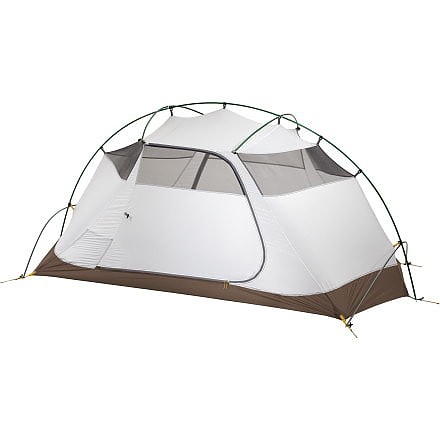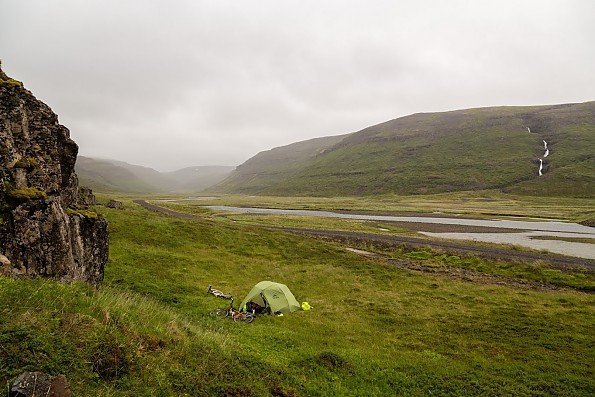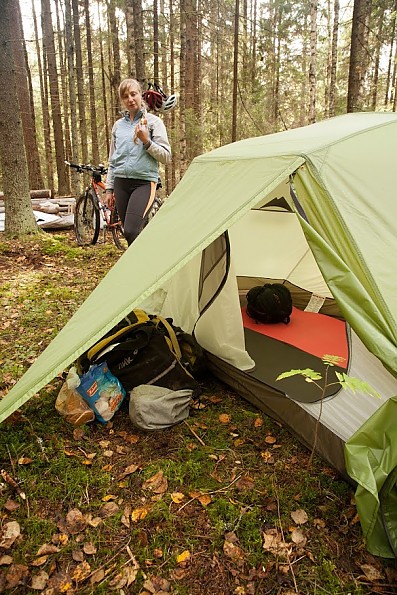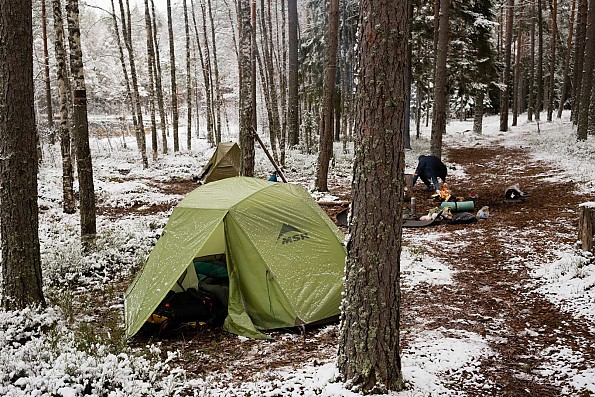MSR Hoop

A unique blend of relatively low weight, huge internal volume, and good durability. Perfect choice for camping in good weather conditions during 3+ seasons. But the wind resistance is not very good, and also this tent may be too heavy, large and warm for some users.
Pros
- Excellent internal volume for such a weight
- Optional non-freestanding setup saves additional weight
- Large vestibules with good protection against rain
- Excellent overall quality
- Good stakes (DAC V-pegs) and poles
- Durable siliconized rainfly
- No need of guylines for setup
- Warm inner tent
Cons
- Mediocre wind resistance
- The rainfly stretches when wet
- Poor separation between rainfly and inner tent at the ceiling
- A bit complicated setup, difficult pitching for single person
- Too light floor fabric
- No guylines included
- May be too warm for some conditions
Unfortunately, this tent was discontinued in 2014 after announcement of Elixir model line.
We purchased this tent in late 2012 as a replacement for our Salewa Finch II, which weighs the same 2.5 kg (5.5 lbs). The very first impression we got from MSR — huge internal space! Because of near square cross-section (the side walls are vertical), two or even three people may comfortably sit inside the tent along with their cookware, and lot of space will remain unused.
The ceiling is very high above (given my height of 184 cm / 6 ft, I have about 15 cm / 6 in clearance with the ceiling), and the tent length of 240 cm (8 ft) allows placing half of the gear inside the tent, if necessary. The width of 130 cm (4.5 ft) is a very good value for a double tent though. In general the internal space is large enough to shame some tents which weigh 1 kg (2 lbs) more.

I needed 4 guylines to pitch the tent in quite strong wind in Iceland
Inside the tent there are 4 pockets — 2 on walls and 2 on ceiling. Two large vestibules offer very good coverage against the rain, which makes possible sitting under the rain with opened rainfly door — the water will not get neither inside the tent nor on your gear in vestibule. Also the inner tent is warm and dense enough to open the rainfly even in challenging weather conditions. Thus it’s easily possible to cook on stove outside the tent without leaving your sleeping bag. The inner doors themselves have a medium size.
The tent is freestanding, but you can always abandon this feature by leaving two bottom cross-poles at home, saving additional 200 grams (7 oz). It is very useful for backpacking in calm weather conditions when you expect pitching on dense soil (no sand, rock or snow). The tent pitching is not fully straightforward — it’s better to do it in company with somebody. Also all four cross poles are installed with some amount of brute force, which may not fit for women.

In Iceland we faced full storm conditions — it wasn't possible to pitch the tent on the outside
The tent is warm (may be too warm for sunny summer days) — the rainfly has a small ground clearance (about 5 cm / 2 in), and you can shut the upper vents in the rainfly. You may operate the vents from inside the tent — such features distinguish the good tents from the best ones.
And there are some more — I am really impressed with MSR quality and attention to small details. The inner tent fabric is quite dense and water-resistant, the mesh windows are small enough. The claimed 3+ season ability is quite fair — this tent can be easily used at freezing temperature, and sometimes we were sleeping in this tent at temperatures as low as -20 °C (-5 °F).
The inevitable tradeoff for huge internal space and reasonable weight of this tent — its wind resistance. You have only 1 pole, large height and steep walls, so the tent cannot hold really strong winds without risk of breakage. Luckily the rainfly has 6 guyline attachment points, but the guylines themselves are not included. If you travel away from home, it’s strongly advised to purchase and get ready all 6 guylines with line tensioners and pegs. You'll need the guylines at winds starting from 10 m/s (20 mph).
In '2011 Outdoor Magazin test this tent broke at wind speed of 20 m/s (41 knot) when using all the guylines. It equals to severe gale wind force. For comparison, Hilleberg Nallo broke at 33 m/s (65 knots) in the same test, which qualifies for hurricane force.
Also the rainfly has a noticeable sag in wet condition. During the rain or in severe condensation conditions it's often necessary to re-tighten the fly, or you'll get the contact between two tent layers at the ceiling. But the inner tent is water resistant, so there is no dipping to inside anyway. Interestingly the rainfly is semi-transparent due to its lightweight fabric and thus it offers little protection against shining sun. But you may unbuckle 3 clips on one side of the tent (on photo below) and fold the rainfly twice — in this case it dries quickly and offers good sun shade plus the best possible ventilation.
We had been using this tent for 3 years in row in most outdoor activities (in 2013 we also purchased the ultralight Big Agnes Seedhouse SL2 tent for fast and light summer trips). Even now the tent offers full protection against the rain, and its floor is still 100% watertight (once we had a night in the middle of puddle and once — on the bottom of stream). The rainfly fabric is thin but strong, especially in comparison to ultralight Big Agnes. But the floor is not very strong for the tent of this class — you may still use the tent without the footprint, but it’s a good idea to have one. It would be good if this tent had a thicker 70D fabric on the floor instead of 40D.
This tent is my favorite one so far. For reasonable amount of money it offers a unique blend of relatively low weight, huge internal volume, excellent overall quality and good durability. Of course it has some limitations, and using it in really harsh weather may lead to problems. But it’s still suitable for most conditions that the general user may encounter in his trips.

The real challenge — 10 days in Crimea at temperatures around +30°C (85 °F)
We stopped using this tent after our child was born in mid-2015. Unfortunately, despite the large volume, the tent width is not suitable for three. So we purchased the Marmot Limelight 3P tent for the same 250$ we paid for MSR. But the design of Marmot and lack of attention to details don’t match either the MSR level, nor our expectations from Marmot brand. Also we decided that for family use the classic design with inner poles is not suitable, as sometimes I need to pitch the tent under the rain without any assistance.
So we’ve just purchased the Hilleberg Kaitum 3 tent. It is going to replace both of our bigger tents: Marmot for family trips and MSR for more challenging trips without the child. It is not freestanding and has a weight penalty, but it is a true 4-season tent which may handle strong winds with ease, offering enormous internal volume and very easy pitching in the rain.
Source: bought it new
Price Paid: 250$
A little heavy but a very nice tent for two taller people, or someone like me who is tall and lets his two 55lb dogs sleep in the tent with him.
Pros
- Large for a 2P tent
- Many different setup options
Cons
- A little heavy
I have only used this tent once, but since there were no other review I decided to go ahead and post a review here and update it if needed after more uses.
In these two pictures I have it set up in my ready-for-rain mode because it was suppose to rain that night and I wanted a view until that started. The tent breathed quite well with the half rain fly, then as I was drifting off it started to rain, so I quickly pulled the rainflay over and clipped it into place.
Unfortunately in my haste and grogginess from being half awake I did not open the vents, and as a result a half hour later I woke up overheating. I realized the problem after a few minutes and opened the vents which are held open by a plastic pieces with velcro sewn into the rainfly. Once open things cooled off fairly quickly.
I have more pictures I will upload, but in these photos I did not set up the poles that make this tent freestanding, one of the three setup options along with the lightweight mode with just the poles rainfly and a footprint.
As you can see the tent is not that tall, but I am 6'4" but I had plenty of room to sit up and strectch all the way out without me or my 77" long length pad touching the ends of the tent.
As I mentioned earlier the night I used it it was suppose to rain and did rain. I am pleased to report that me, the actual tent, and the two fairly large vestibule areas stayed perfectly dry.
Source: bought it new
Price Paid: $275
A great lightweight and spacious backcountry tent for two.
Pros
- Strong geometry for varied conditions
- Spacious for two
- Multiple setup configurations
I was the manager of a local gear shop in Flagstaff, Arizona (Four Season Outfitters). My girlfriend was interning in Yellowstone last summer and I decided it was about time that she had her own tent.
She had some specific stipulations that were difficult to find. However, the MSR Hoop fulfilled them and fulfilled them well! So, to start, I know most people will get all butt hurt and not look at this 2-person tent because it weighs 4lbs 8oz. That's fine.
This tent is absolutely bomber for "3" season sil nylon tent. All you ultra minimalists/sub 3lb 2 man tent people can go get something that will blow away in 20 mph winds. We've had this tent set up in the desert southwest, rainy pacific northwest, and up on Rainier. It has seen 50 mph winds, stood up to a 2 foot snowfall, and 48 hours of straight rain. Although I still wouldn't classify it as a 4-season tent, this tent is a SOLID 3+ season shelter.
It can be setup multiple ways. You can set up the Hoop free standing, non free standing, or fast pitch style with the optional foot print. Depending on the weight/conditions you expect, you can set up the tent with or without the two small poles on either end. These obviously add strength and stability (and the free standing aspect) but some weight. If you aren't concerned with that, don't pack those poles and you can set it up non free standing and save a few ounces.
I bought the footprint and have set it up fast pack style as well, just rain fly, poles, and footprint. This tent is mainly fabric versus mesh, so it keeps the breezes out and increases privacy when the fly isn't on (big for us in the Southwest). Dual doors and vestibules. Has internal pockets, both upper and lower, to stash your gear. Perfect amount of space for my girlfriend and I when out on backpacks. I wish it had a gear loft but I rigged one up myself.
If you are looking for a stout tent that can handle almost anything, look at the Hoop!
Source: bought via a "pro deal"
Price Paid: $250
Your Review
Where to Buy
You May Like
Specs
| Price |
MSRP: $349.95 Historic Range: $184.34-$349.95 Reviewers Paid: $250.00-$275.00 |
| January 2011 | |
|---|---|
| Minimum weight |
4 lb 8 oz / 2050 g |
| Packed weight |
5 lb 7 oz / 2500 g |
| Seasons |
3-season |
| Sleeping capacity |
2 |
| Doors |
2 |
| Floor length |
8 ft 0 in / 240 cm |
| Floor width |
4 ft 4 in / 130 cm |
| Floor area |
47 sq ft / 4.4 sq m |
| Vestibules |
2 |
| Vestibule area |
18 sq ft / 1.7 sq m |
| Peak height |
44 in / 112 cm |








